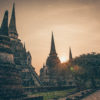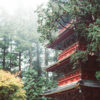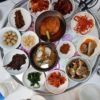[tminus t=”25-10-2017 14:50:00″ id=”korea” style=”darth”/]
Baegyangsa - Zen and the art of Korean vegan cooking
We have come to the edge of her garden on the grounds of the Chunjinam hermitage of the Baekyangsa temple, 169 miles south of Seoul. Kwan is revered around the world for her cooking, but she is first and foremost a Zen Buddhist nun, and this garden reflects the come-what-may equanimity of her spiritual practice. If insects want to land and feast here, they are welcome to — through a translator she tells me that she does ‘‘nothing’’ to dissuade them. ‘‘That’s why it’s not pretty,’’ she says. If a wild boar makes off with a pumpkin, well, so be it — the garden has no fence around it, and it seems to blur into the surrounding forest in a way that suggests the playground remains open to beasts of all types.
I have been at the temple for a day or so, having slept on the floor of a stark, cabinlike visitors’ dormitory, and having awoken at around 3 in the morning to watch the monks of Baekyangsa chant and bow in the moonlight. By now I have listened in on several conversations about Buddhism and food: lively exchanges between Jeong Kwan and Eric Ripert, the French chef from Le Bernardin in New York City, a Buddhist who has made his second pilgrimage to the monastery to bask in the nun’s presence — and eat her food.

But even if you can talk about food for hours, there comes a point when you need to make contact with it. Which is why Kwan has led us to the garden. Here, she coos over pumpkin blossoms, green chiles and eggplant, and shows me how to pluck leaves of mint and perilla — gently, with a moist pinch between my thumb and index finger at a firm spot on the stem. The leaves are placed in a wide basket; shortly they’ll be carried up the hill and incorporated into a meal. But for a moment I am encouraged to hold the leaves to my nostrils and breathe in their herbal fragrance.
Kwan believes that the ultimate cooking — the cooking that is best for our bodies and most delicious on our palates — comes from this intimate connection with fruits and vegetables, herbs and beans, mushrooms and grains. In her mind, there should be no distance between a cook and her ingredients. ‘‘That is how I make the best use of a cucumber,’’ she explains through a translator. ‘‘Cucumber becomes me. I become cucumber. Because I grow them personally, and I have poured in my energy.’’ She sees rain and sunshine, soil and seeds, as her brigade de cuisine. She sums it up with a statement that is as radically simple as it is endlessly complex: ‘‘Let nature take care of it.’’
All of which puts her in the same camp as some of the most influential leaders in international gastronomy — chefs like Michel Bras and Alain Passard, Dan Barber and David Kinch. There is a crucial difference, though. Jeong Kwan has no restaurant. She has no customers. She has published no cookbooks. She has never attended culinary school, nor has she worked her way up through the high-pressure hierarchy of a four-star kitchen. Her name does not appear in any of those annual round-ups listing the greatest chefs in the world, although Ripert will assure you that she belongs among them, as do a few contemporaries of hers at temples throughout Korea.
Panda World
Everyone loves pandas; not least the people of Korea who have been flocking in their tens of thousands to Everland Resort’s Panda World.
While the stars of the attraction are undoubtedly pandas Ai Bao and Le Bao, the enclosure itself has been praised by China’s conservationists as the new global standard for panda environments.
 Blooloop spoke to architect Kieran Stanley (left), CEO & Creative Director of dan pearlman, the company tasked with creating an immersive experience that keeps the guests and the pandas happy.
Blooloop spoke to architect Kieran Stanley (left), CEO & Creative Director of dan pearlman, the company tasked with creating an immersive experience that keeps the guests and the pandas happy.
dan pearlman, based in Germany, has something of a track record in the design of zoo experiences including the ground-breaking Islands at Chester Zoo.
“Everland really wanted something special for their 40th anniversary and were willing to invest around $15 million, ” explains Stanley. “They ran an international competition, which we won.”
Paws for Thought
He attributes their success not only to the unique design, but also to the exhaustive global research dan pearlman conducted, talking to scientists and biologists and contacting every institution that keeps pandas.
“They told us about their experiences and insight. We have our own zoological expertise for these kinds of projects, but pandas are very special and we wanted to get a really informed insight. We also got testimonials that said if dan pearlman wins this competition, we are more than happy to join their team to develop this idea further. That demonstrated confidence in us as a company, as well as in our concept.”
“So that was the beginning. Then we started our design work.”
Challenging Topography and Limited Space

dan pearlman had already worked with Everland on the park’s Lost Valley attraction so were familiar with the resort and its many challenges.
“One of the special challenges with this site was that we’re right in the middle of the park. It is always awkward if you’re trying to build in the middle of an operating park. Additionally, the topography of the park is hilly and steep: it was a very tied in, restricted site.”
With space at a premium, the team had to find the most efficient way to accommodate guests and animals. They also needed to rationalise the infrastructure so that elements such as pathways linked with those already in place.
“One of the great challenges is to maintain the balance between the space for the animals, the visitors, and the operations. And, in this sort of park project, you do need a lot of space for queue development.”
The solution was to double the height spaces of the building, siting the exhibition space over the retail and gastronomy spaces. Visitors climb a winding pathway from Panda Plaza and its panda sculptures through a green, water-rich Chinese landscape inspired by China’s Sichuan Province (where pandas are found in the wild), passing a koi pond and otter enclosure.
The point of entry has been specifically designed as a themed landscape entrance, rather than a door, to keep the guests immersed in the experience. Through this, they arrive at the permanent exhibition, which is dedicated to all aspects of panda life. It also educates visitors about species conservation in a way that is both informative and entertaining.
Finally, the visitors arrive at the indoor area where they have an overview of the pandas.
An All-Inclusive Attraction
%20Everland%20Resort%20(1).jpg)
“It’s an immersive experience with the Chinese themed landscape, ” says Stanley. “We paid specific attention to the plants and flowers we planted. There’s also an olfactory experience where visitors can both see and smell the landscape that’s blooming.
“Guests follow a waterway, a stream we designed beside the path, uphill to the top, and then enter the building. When the guests reach the upper level, the animal holding is underneath them. They arrive into the inside hall where the animals are. They then start with an overview, comprising numerous different perspectives of the pandas.”
The landscape on the indoor level has been meticulously designed to mimic the pandas’ native habitat, with rocks, flowing water and bamboo. It is also aesthetically pleasing to the visitors.
Temperature and airflow are minutely regulated to optimise conditions and ensure the pandas’ wellbeing.
“Pandas are used to temperatures of between five and fifteen degrees. They don’t like it when it gets too hot, ” says Stanley.
“Because you have animals and people who need certain temperatures respectively all in one space, you need to control temperature locally. It’s all atomized, there’s a high tech screen headquarters in the back of house which controls all this. Every part of the enclosures are observed by cameras so the panda behaviours can be scrutinised at any time. If and when they start breeding, the areas are all set up.
“There’s a lot of special programme in there for that budget. I think a big challenge of the project was not only the special parameters within the site, but the planning necessary to pack such a large amount of space and programme into those parameters in a very compact way, so as to get the most out of the site.”
Clever Storytelling
%20dan%20pearlman%20Experience%20Architecture.jpg)
While the design moves the visitors in one direction through the exhibit, the pandas are free to move at will inside and out.
“The guests’ journey continues through the beautiful landscape among bamboo, ginko and coniferous trees, streams, waterfalls and rock formations, where they see the outdoor panda enclosures. There are other species – red pandas and golden monkeys in the overall environment, in their own enclosures.
“And, on the way out, we continue the story, exploring it in a mythological way. There’s a giant panda statue in a cave which tells you a bit about folklore of pandas in Chinese culture. Then, you continue along a path past the golden monkeys, back into the building again and now you’re underneath where the visitors originally entered, on the lower level, exiting through the shop.
“When you leave the building, you’re in front of the restaurant. So, it’s conceived to be a journey into the lives of pandas and their natural habitat; we tell you stories along the way, you can buy something, and then have a bite to eat. It’s an all-inclusive attraction.”
Animal Welfare in a Theme Park Context
%20dan%20pearlman.jpg)
Of course, when you give the pandas such a naturalistic environment, they behave in a naturalistic way. All well and good in a zoo but in a park where delivering fun is a priority, this behaviour brings its own challenges.
“It’s a different approach: more slanted towards fun than a traditional zoo, ” agrees Stanley. “Our task centred around both animal welfare, and being within the context of a fun park. There is a special focus on the guest experience.
“The challenge with pandas is that they sleep and they eat. In between, they’re very active when they’re active. However they’re also very asleep when they’re asleep, and they alternate, so they’re awake and asleep all through the night and the day.
“If you’re unlucky you spend two hours queuing, and don’t even see a panda awake.
“So we needed to compensate, and to make sure the guests would see something they would enjoy.”
The exhibition bridges this gap, absorbing guests in the world of the panda, managing expectations and preparing them to expect natural behaviours.
“They can learn about the life of pandas and the special abilities they have. These include the strength of their jaws (which can crush huge bamboo shoots), the amount of bamboo they eat and their behavioural traits.
“And, you can learn about all these things at night time, as well. There’s actually a night time exhibit, as pandas are also active then.”
360° Projection Pre-Show Regulates Visitor Flow
%20dan%20pearlman%20Experience%20Architecture.jpg)
The exhibition also plays a crucial role in managing put-through:
“It’s a walk-through attraction, so it’s a really important part of the control to regulate how many people go through at any one time. At the entrance, there’s a 30-person, 360 degree projection that introduces the pandas and tells their story in Korean. It’s an attractive pre-show, and it functions to control the amount of people going through the space.”
With a daily average of ten thousand visitors, Panda World clearly owes much of its continued success to the smooth passage of visitors through the attraction.
“It’s been a huge success, ” confirms Stanley. “Everland has been very happy with the result. The queue line has functioned well and the guests flow through the space, so there are very few delays.”
Is he personally pleased with the end result?
“It is beautiful, ” he says. “I’m very happy with how the whole thing turned out, except perhaps for the surface floor of the indoor areas. They ran out of time so they used this roll up grass. It looks a bit… roll up grassy.”
The Global Standard for Panda Environments

Pandas Ai Bao and Le Bao, on loan from China, moved into their new home in March this year. On the 21st of April, they greeted the general public for the first time and have been thriving ever since.
For Stanley, it is, perhaps, this part of the project that gives him the most satisfaction.
“There are three conservation bases in China. They have visited Everland, and proclaimed my project to be the new global standard for panda environments.
“I was just really happy when Everland told me how delighted they were.”
Hardly surprising, then, that dan pearlman has been commissioned to design the new enclosure for Berlin Zoo’s pandas, due to arrive from China in 2017.
All in all, a furry tale ending.
%20Everland%20Resort%20(1).jpg)
bibimbap festival
Jeonju Bibimbap Festival (전주비빔밥축제)
Period10.26.2017 ~ 10.29.2017
Address20, Hyeonmu 1-gil, Wansan-gu, Jeonju-si, Jeollabuk-do
전라북도 전주시 완산구 현무1길 20 (경원동3가)
Location Korean Cultural Heritage Hall of Fame
Telephone• 1330 Travel Hotline: +82-2-1330
(Korean, English, Japanese, Chinese)
For more info: +82-63-231-8969
Bibimbap was one of the top three foods during the Joseon period and it is thought to be the most favorite Korean meal among foreigners. In particular, Jeonju Bibimbap is considered one of the best foods in Korea. It is a nutritious and healthy food comprised of rice with bean sprouts, one of 10 famous foods in Jeonju. Jeonju’s bibimbap is decorated with five colors and witholds five tastes that come from 30 different ingredients including gingko, pine nut, chestnut, walnut and fresh seasonal vegetables. It has a balanced nutrition, packed with carbohydrates, fat, protein, vitamins, and minerals alike. It is considered the perfect food embracing the ancestor’s wisdom and scientific theory.
Jeonju is the center of Korea’s delicious cuisine and its representative food is Bibimbap. Jeonju Bibimbap Festival is held at Korea Traditional Culture Center for 4 days.
————-
Other info
Jeonju city is two to three hours away from Seoul by car or bus, located in the south-western province of North Jeolla. Apart from its trademark bibimbap, the area is known for Jeonju Hanok Village, an area with over 800 traditional Korean hanok houses and the nearby is Gyeongju National Park, which is part of the Gyeongju Historic Area, a UNESCO World Heritage Site.







